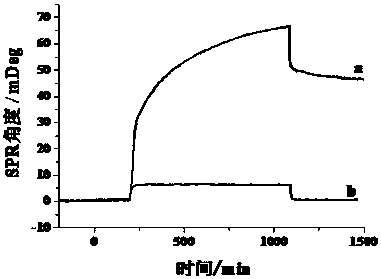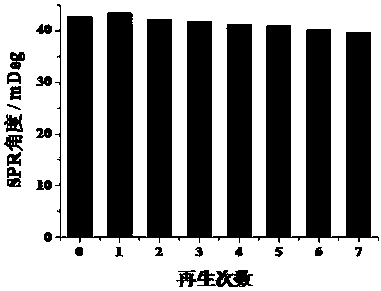A method for the detection of protein kinases based on surface plasmon resonance
A surface plasmon and protein kinase technology, applied in the field of chemistry, can solve the problems of poor protein non-specific ability, complex preparation process and high cost, and achieve the effects of preventing non-specific adsorption, simple preparation and low cost
- Summary
- Abstract
- Description
- Claims
- Application Information
AI Technical Summary
Problems solved by technology
Method used
Image
Examples
Embodiment 1
[0016] The preparation of SPR sensor chip, the steps are as follows:
[0017] (1) The gold film with a thickness of 50 nm was purchased from Biosensing Instrument Company, USA. The basic composition of the company's gold film is to coat a 18 mm × 18 mm glass slide with a 2 nm thick Cr metal film to enhance the bonding force between gold and glass, and then coat it with a 50 nm thick Cr metal film. Gold as the sensing layer;
[0018] (2) The gold film was soaked in absolute ethanol for 10 minutes before use, ultrasonicated for 5 minutes, rinsed with secondary water, and cleaned with N 2 blow dry;
[0019] (3) After cleaning, use H 2The flame is annealed on the surface of the gold sheet, preheated first, and then at an angle of 45 degrees H 2 Flame uniform annealing for 30 seconds to clean the surface and eliminate non-specific adsorption;
[0020] (4) Peptide P1 was dissolved in secondary water to 1 mM, then diluted to 10 µM with 10 mM PBS solution of pH 7.2, and polypepti...
Embodiment 2
[0024] The specific and non-specific effects of protein kinase A on the surface of the gold film in Example 1, the steps are as follows:
[0025] (1) Protein kinase A was diluted with 10 mM pH 7.2 PBS buffer;
[0026] (2) Place the prepared P1 / P2 modified gold film on the SPR instrument, when the baseline is stable, flow inject 25 nM protein kinase A solution, and record the SPR response signal until it becomes stable. The carrier liquid is 10 mM PBS buffer solution, pH 7.2, and the flow rate is 10 µL / min;
[0027] (3) Place the prepared P2-modified gold film on the SPR instrument. When the baseline is stable, inject 25 nM protein kinase A solution and record the SPR response signal until it stabilizes. The carrier liquid is 10 mM PBS buffer solution, pH 7.2, and the flow rate is 10 µL / min;
[0028] (4) Compare the SPR response signals of the protein kinase A solution injected on the surface of different gold membranes, such as figure 2 Shown: protein kinase A produced a s...
Embodiment 3
[0029] Embodiment 3: the regeneration of sensor chip, the steps are as follows:
[0030] (1) Dilute protein kinase A with 10 mM, pH 7.2 PBS buffer;
[0031] (2) Place the prepared P1 / P2 modified gold film on the SPR instrument, when the baseline is stable, flow inject 25 nM protein kinase A solution, and record the SPR response signal until it becomes stable. The carrier liquid is 10 mM PBS buffer solution, pH 7.2, and the flow rate is 10 µL / min;
[0032] (3) Inject 50 mM NaOH solution into the detection channel of step (2) at a flow rate of 10 µL / min to elute the protein kinase A bound to the surface of the sensing gold membrane, allowing the sensing gold membrane to regenerate until the SPR signal Reach the size before the injection of protein kinase A to prepare for the detection of the next sample;
[0033] (4) Inject the same concentration of protein kinase A solution as in step (2) onto the surface obtained in step (3), record the SPR signal until the baseline is stabl...
PUM
 Login to View More
Login to View More Abstract
Description
Claims
Application Information
 Login to View More
Login to View More - R&D
- Intellectual Property
- Life Sciences
- Materials
- Tech Scout
- Unparalleled Data Quality
- Higher Quality Content
- 60% Fewer Hallucinations
Browse by: Latest US Patents, China's latest patents, Technical Efficacy Thesaurus, Application Domain, Technology Topic, Popular Technical Reports.
© 2025 PatSnap. All rights reserved.Legal|Privacy policy|Modern Slavery Act Transparency Statement|Sitemap|About US| Contact US: help@patsnap.com



